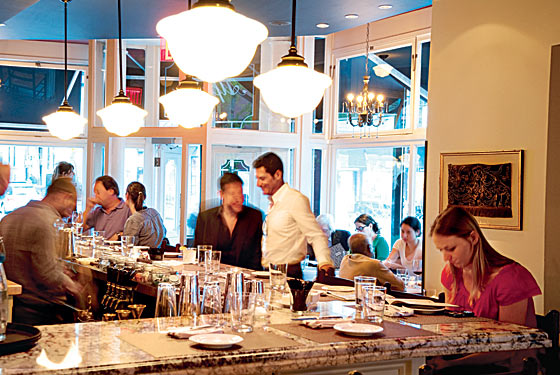
So when, precisely, did osteria and trattoria replace brasserie as the catchword for casually chic, Continental-style dining in this city? For argument’s sake, let’s date the first stirrings of the trend back to Mario Batali’s great faux-Roman osteria Lupa, which opened in the Village more than a decade ago. Since then, studiously chic, nouveau-rustico Italian establishments have been popping up around town like mushrooms. These restaurants tend to have snappy names (Crispo, Morini, Maialino). Many occupy cramped, neighborly spaces with fake rafters on the ceilings and have dining counters designed largely for the consumption of Italian wines. The menus are filled with crudo appetizers and carefully curated salumi boards (frequently featuring that great Batali favorite, lardo). The pastas are earthy and handmade, and the ragùs are often freighted with faithfully authentic peasant delicacies like coxcombs, stewed tripe, and cured pork jowls.
You will find many of the totems of the nouveau-rustico movement on display at Spasso, which opened early this year, on the corner of Hudson and Perry Streets in the West Village. There’s the bouncy, Bastianich-style name (“amusement” in Italian), and the slightly awkward storefront space, which in this case has been fitted with not one but two cramped dining counters. There are the carefully chosen, modestly priced Italian wines (just 120 bottles of them) in the cellar and the de rigueur selections of house-cured salumi (coppa with roasted peppers, lardo with rosemary) and crudo (amberjack with sea urchin). Spasso’s chef and partner, Craig Wallen, has studied under many of the high priests of the rustico movement (with Michael White at Convivio, and at Lupa itself), and his designer pastas are “hand-rolled,” according to the restaurant’s website, and dressed with properly earthy ingredients like chopped pork shoulder and braised duck leg.
“I think we’ve seen this movie before,” said my friend the Pasta Snob, as the first flurry of small-plate dishes hit our table. They included oily bits of rabbit sott’olio obscured in thatches of arugula, and helpings of fried oysters served with a nice crema sauce touched with Meyer lemons. I enjoyed the silvery Mediterranean sardines with a scattering of chickpeas, although the lardo was bunched in ribbons on little round knuckles of dough that tasted, according to one of my guests, “like old garlic knots.” The amberjack crudo received similarly unhappy reviews (it was garnished with fishy-tasting sea urchin and drowned in extra-virgin olive oil), as did the Tuscan ribollita vegetable soup, which was properly stocked with stewed vegetables and prosciutto but seemed to have been flavored with trowels of salt.
Many of the primi pasta items my tasters and I sampled were equally uneven. I didn’t mind my helping of slightly tough orecchiette tossed with rock shrimp and shreds of crab (the ear-shaped pasta being another totem of nouveau-rustico cuisine) or the buttery buttons of ravioli, which the kitchen stuffs with spring peas and tiny bits of prawns and scatters with crunchy fried bread crumbs. But the veal agnolotti I ordered one evening were square and stubby and drenched in the inevitable brown-butter sauce, dressed here with flaccid (as opposed to frizzled and crispy) sage leaves. The triangular, mushroom-stuffed pansotti had a nice nutty taste to it, but the Sardinian-style “maccheroni” was dressed in a smothering pork ragù and tasted “like pasta out of a box,” according to the increasingly testy Pasta Snob, and a tangle of spaghetti al pomodoro was seized in a tomato sauce as thick as toothpaste.
The best secondi at Spasso tend to be safe, old classics, like country chicken sweetened with old-fashioned Marsala sauce, and a trio of grilled lamb chops garnished with a tomato marmalade and a touch of sweet vincotto. The seafood stufato (a stew stuffed with mussels, at least one head-on prawn, and thick chunks of fennel) was a clunky, workmanlike version of this classic dish, so if you’re in the mood for fish, try the grilled snapper with braised artichokes or the trout saltimbocca, which is wrapped in a blanket of crisped prosciutto and flavored with sage. The seared duck breast, on the other hand, was livery tasting (it comes with a gluey farro risotto), and the extravagantly priced ($80 for two) côte de boeuf special, which I ordered medium rare one evening, came to the table cut in purple, barely edible slices.
Not that many of the diners at Spasso seemed to notice these transgressions. On the contrary, the little room was overrun, on the evenings I visited, with the kind of people (Village locals, Euro snobs, assorted downtown poseurs) who used to haunt the latest, trendy neighborhood French brasseries, when those restaurants were in vogue, at the tail end of the past millennium. They addled themselves with cocktails touched with Campari (instead of Lillet) and bottles of wine from Lazio and Friuli (instead of Alsace and the Rhône Valley). The desserts at Spasso include selections of Italian country cheeses (goat from the Piemonte region, sheep from Puglia) and a smooth house panna cotta (panna cotta being the rustico equivalent of crème brûlée) flavored with rhubarb and pistachio. The specialty of the house, however, is the fresh-baked bomboloni fritters (rustico for “profiteroles”), which are tossed in citrus sugar and served, in classic brasserie style, with a glass of rich chocolate cream sauce on the side.
Spasso
Address: 551 Hudson St., at Perry St.; 212-858-3838
Hours: Dinner Sunday through Wednesday 5 to 10 p.m., Thursday to 11 p.m., Friday and Saturday to midnight. Brunch Saturday and Sunday 11 a.m. to 3 p.m.
Prices: Appetizers, $7 to $15; entrées, $15 to $29.
Ideal Meal: Orecchiette with rock shrimp, roasted chicken, bomboloni fritters.
Note: The restaurant’s new weekend brunch menu includes a signature house Bloody Mary, and fried eggs smothered in tripe ragù.
Scratchpad: The rustico cooking may improve over time, but right now this is strictly one-star neighborhood fare.
